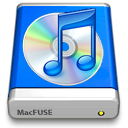
Mulle kybernetiK
presents

 |
Mulle kybernetiKpresents |
 |
| iTunesFS | by ZNeK |
Q: Why doesn't my iPhone / iPod Touch show up?
A: Neither iPhone nor iPod Touch can be mounted as ordinary removable devices
without help of third party solutions.
Q: How do I share the iTunesFS filesystem via Samba?
A: Unfortunately, sharing the iTunesFS filesystem via
Samba doesn't work. I have tried to debug the issue in the past
and came to the conclusion, that the problem is buried deep in FUSE/Samba
interaction. If anybody can shed any light on this issue any hints are
appreciated. For the time being, resort to
sharing iTunesFS via Apache.
Q: Can I use the
Fink package of MacFUSE instead of the Google one?
A: No, you need MacFUSE Core as stated on the download page, sorry!
Please note that it's normal for iTunesFS not to bounce in your dock! This is intended behaviour, as iTunesFS is not really an ordinary Desktop application with a menu, but rather a file system (you can tell that by looking at the screenshot in case you still have doubts).
If you don't see the iTunesFS Volume appear in Finder shortly after you started the application, something unexpected has happened…
Popular reasons that cause iTunesFS to fail are:
Update: since version 1.1.9, iTunesFS can detect the location of the iTunes Music Library properly!
iTunesFS expects the
iTunes Music Library.xml file to be in the standard default
place, that is ~/Music/iTunes/iTunes Music Library.xml (where
~ designates your home directory).
If you happen to have changed that location, all is not lost -
fancy iTunesFS sports a nifty user default
just for that case! ;-) Open Terminal.app and type the following:
defaults write com.mulle-kybernetik.znek.iTunesFS Library COMPLETE_QUALIFIED_PATH_TO_YOUR_ITUNES_XML_FILE
Make sure to apply proper quoting/escaping in a shell, i.e. use backslash escapes for spaces and the like. For setting the path to the default library file in a proper manner, you would have to type:
defaults write com.mulle-kybernetik.znek.iTunesFS Library ~/Music/iTunes/iTunes\ Music\ Library.xml
As you might know, neither iPhone nor iPod Touch can be mounted as an ordinary removable device as previous iPod generations allowed you to. However, there are efforts on the way to make that happen nevertheless. Using one of these projects, it's pretty easy to convince iTunesFS to read the contents of such a device. Following is a mail thread detailling a possible method. Enjoy!
#!/bin/sh
# Auhor: Allen Porter
mkdir /Volumes/iPhone
./iphonedisk_mount -o volname=iPhone -o volicon=./iPhoneDisk.icns /Volumes/iPhone
mkdir /Volumes/iPhone
./iphonedisk_mount -o defer_auth -o volname=iPhone -o volicon=./iPhoneDisk.icns /Volumes/iPhone
$ ./mount.sh
Initializaing.
Waiting for device...
Initializing filesystem.
Mounting iPhone Volume.
$ ls -l /Volumes/iPhone/
total 136
drwxrwxrwx 2 root wheel 68 Jan 1 1970 ApplicationArchives/
drwxrwxrwx 2 root wheel 136 Jan 1 1970 DCIM/
drwxrwxrwx 2 root wheel 102 Jan 1 1970 Downloads/
drwxrwxrwx 2 root wheel 136 Jan 1 1970 Photos/
drwxrwxrwx 2 root wheel 68 Jan 1 1970 Podcasts/
drwxrwxrwx 2 root wheel 68 Jan 1 1970 PublicStaging/
drwxrwxrwx 2 root wheel 68 Jan 1 1970 Purchases/
drwxrwxrwx 2 root wheel 136 Jan 1 1970 Recordings/
-rw-rw-rw- 1 root wheel 0 Jan 1 1970 com.apple.itdbprep.postprocess.lock
-rw-rw-rw- 1 root wheel 0 Jan 1 1970 com.apple.itunes.lock_sync
drwxrwxrwx 2 root wheel 204 Jan 1 1970 iTunes_Control/
-rw-rw-rw- 1 root wheel 30624 Jan 1 1970 jailbreak.log
defaults write com.mulle-kybernetik.znek.iTunesFS iPodMountPoints -array /Volumes/iPhone
I hope this is correct. Out of curiosity, what was your idea to enter the option you wrote above?$ ./iTunesFS.app/Contents/MacOS/iTunesFS -iTunesFileSystemDebugEnabled YES -iPodMountPoints '( /Volumes/iPhone )'
